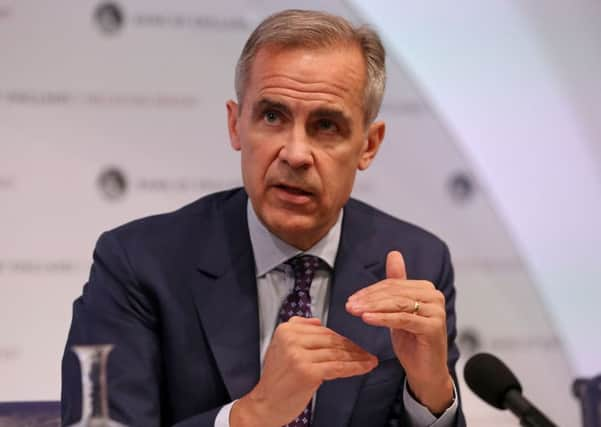Bill Jamieson: Carney can still press the panic button


Instead, he signalled the bank’s broad guess for the future – not a target or a specific forecast – was that interest rates were “likely to remain materially below the 5 per cent level set on average prior to the crisis” and settle at between 2 to 3 per cent in the long term.
An ageing population, greater propensity to save, and weakness in productivity growth were all cited as reasons why there would be less need to borrow.
Advertisement
Hide AdAdvertisement
Hide AdIn later interviews he also set out his belief that, rather than last week’s rise heralding a spate of rate increases, movements were likely to be confined to one a year.
Reassuring news, surely, for businesses and mortgage borrowers alike. A disturbing pattern in the past was for the central bank to delay a rise in rates and then play frantic catch-up with a rapid-fire burst of further increases. Certainly a return to the world of 5 per cent borrowing costs – never mind the peaks of 10 per cent plus in the early 1990s – would spell deep trouble for companies and homeowners.
And there was always a lingering fear that as we moved out of the ultra-loose emergency monetary policies that have prevailed for the past ten years, we would revert to the rate regime of previous decades. Few in the bank or across the wider economic cognoscenti envisaged in the immediate aftermath of the financial crisis that we would have moved to a radically “new normal” of interest rates between two and three per cent as far ahead as we could see.
But that’s the problem with the signalling of a new era: how confident can we be that it is indeed a “new normal” – one that few saw coming? What unforeseen events might lurk round the corner to disrupt the current assumptions? The bank has also lowered its forecasts for global growth this year and next, blaming heightened trade tensions. It predicts the world economy will expand by 3.75 per cent this year and 3.5 per cent in 2019.
To be fair to the governor, his remarks were hedged with caveats. The most immediate is uncertainty over the outcome of Brexit negotiations and the possibility of a major hit to business confidence and investment. The possibility of a no-deal Brexit, Carney told the BBC, is “uncomfortably high” and “highly undesirable”. It would mean a disruption to trade and a disruption to economic activity, as well as higher prices for a period of time. In such circumstances who would rule out an emergency interest rate reduction to help steady nerves?
Meanwhile, the bank has to wrestle with a puzzle, or rather, two.
The first is why the UK’s economic growth, despite a decade of quantitative easing and ultra-low interest rates, has been so lacklustre. These were, in monetary terms, the perfect conditions for an economic boom. But no boom has emerged and the bank does not envisage any significant quickening of the pace in the period ahead.
Our pallid growth rate is ascribed to poor productivity – but there is no agreement on how the figures should be interpreted and revised figures earlier this year suggested that productivity performance was not as bad as earlier suggested.
Advertisement
Hide AdAdvertisement
Hide AdNow add to this the growing scepticism over official GDP statistics and in particular whether they are capturing the improvements wrought by information technology and the advances of the digital era. That we have record numbers in work and a large backlog of unfilled vacancies would suggest that for now companies prefer staff handling to investment in new, efficiency-enhancing technology.
The second puzzle is why the bank appears so relatively sanguine about household finances, given the latest pointers on personal borrowing. ONS figures last week revealed that UK households spent some £900 more on average than they received in income last year, pushing their finances into deficit for the first time since the credit boom of the 1980s.
It calculated the shortfall at almost £25 billion, with the overspend mostly financed by borrowed money and savings. Last year the government was warned that the UK’s consumer credit bubble of more than £200bn was unsustainable.
Looking at the latest economic signals, the purchasing managers index for the dominant services sector slowed to a three-month low last month while a slowdown in new business growth does not bode well for a renewed pick-up in activity in the near term at least.
Nor does it look any better for manufacturing. A slowdown in new orders growth to a 13-month low last month and manufacturers’ optimism dropping to a 21-month low fuel concern that manufacturing activity is set for further softness. The only bright spot was that export orders picked up to a six-month high in July, but even here the outlook is uncertain. Howard Archer, chief economic adviser to the EY ITEM Club, says the latest Markit/CIPS manufacturing purchasing survey points to the sector faltering in July after a weakened performance over the first half of 2018 compared with the robust growth seen in the second half of 2017.”
The one encouraging report came from the construction sector. The purchasing managers index showed activity at a 14-month high in July, led by the strongest house building performance since December 2015. Commercial activity was also at a 31-month high while civil engineering was at a 12-month high. New orders growth picked up to a 14-month high.
On balance, it looks unlikely that overall economic growth will cause the Bank to hit the interest rate button again for the foreseeable future. But beware of talk about a “new normal”. Economic history is studded with ruptures caused by unforeseen events. The most confident predictions about inflation have foundered in the past. And this is a Bank of England governor whose previous “forward guidance” has often proved less than accurate.